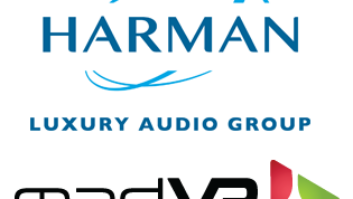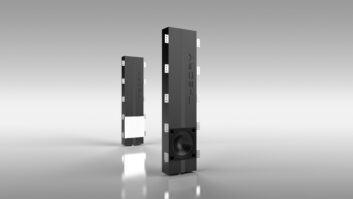Las Vegas – Convergence, convenience and cosmetic integration in the home were among the highlights of Sony’s 2005 home and portable audio lineup, unveiled here during a national dealer show.
Convergence products included the company’s first Hi-MD music player that doubles as a megapixel digital camera. Another example was Sony’s first Ethernet-connected shelf system, which streams music files and Internet radio stations from a networked PC.
Convenience-oriented features included upscaling HDMI outputs that reduce the number of video cables connected to an HDTV set to one and deliver HD resolution from non-HD video sources. A dozen products get the outputs, up from one in the previous line.
Also to enhance convenience, all new Hi-MD portables and all new flash-memory music portable play native MP3 files, eliminating the time-consuming chore of transcoding MP3 files into ATRAC3 or ATRAC3plus formats for playback. The Hi-MD models join the brand’s first hard-disk music portable to support native MP3. In the previous Hi-MD line, no models played MP3 natively, and only a limited number of flash-memory models did.
To integrate home audio products unobtrusively in a home, Sony unveiled its first Dream System home theater system to deliver a 5.1-channel surround experience through two speakers. The company also expanded its selection of flat, on-wall-mountable Dream Systems to two. They blend in with on-wall flat-panel TVs, as does the upscale ES series’s first on-wall speaker system.
In other major developments, Sony:
- expanded its selection of flash-memory portables to 10 SKUs from four to take advantage of an expected surge in demand for flash-memory models. The surge will be fueled by lower prices and higher memory capacities that enhance the size, weight, and battery-life advantages that flash-memory models already enjoy over their hard-disk-drive (HDD) counterparts.
- took its line of Dream System home theater systems further upscale to an everyday $1,999 from a current top-end $899.
- expanded its selection of SACD players to 11 from eight, mostly by adding combination SACD/DVD-Video models. The company also acknowledged that most new SACD titles are coming from independent labels rather than the four major music companies.
- unveiled its first two executive-style microsystems that play CDs encoded with ATRAC3 and ATRAC3Plus files.
- and launched its first microsystem with DVD-Video playback.
In its upscale ES series, Sony unveiled the industry’s lowest priced receiver with upscaling, upconverting HDMI output at $2,000.
Despite the flurry of audio introductions, this year’s Sony line will not include home or portable satellite-radio, AV marketing VP Phil Abrams told TWICE. Satellite radio, however, “is going to move beyond the car,” but just not this year in Sony’s selection, he said. For now, Sony offers XM-ready head units for the car.
The company also has no plans “as of now” to support the Windows Media Audio (WMA) codec in portables, said product manager Kelly Davis.
Details of Sony’s home and portable audio plans follow:
Flash-memory portables: Nine new Network Walkman portables expand the company’s selection to 10 SKUs from four. Two are in the youth-oriented Psyc series.
All feature embedded memory and lack memory-card slots. The lineup includes the company’s first two 1GB models and first four with low-power-consumption organic electroluminescent (EL) display. Some are USB drives; others have a circular shape with LCD screen and up to 70 hours of playback on a single AAA battery. All play native MP3, ATRAC3, and ATRAC3plus files. Windows Media Audio (WMA) and WAV files can be transcoded on a PC to the ATRAC3 formats.
In the 100 series, the flash-memory selection starts with a 256MB model at an expected everyday $99 and includes a $100 512MB model and a 1 GB model at an everyday $149. All three feature backlit LCD screen. Four models in the 400 series feature three-line EL display and rechargeable battery delivering 50 hours of playback time. The selection features two models with 512MB and 1GB capacities at $130 and $180, respectively. Two versions with FM tuners retail for $150 and $200, respectively.
An armband model was also launched.
Hi-MD portables: The Hi-MD Walkman selection remains at four with the launch of four new models, which include the company’s first Hi-MD music player/digital camera and Sony’s first Hi-MD model with EL display. The opening price drops to an expected everyday $149 from $199.
“MiniDisc and Hi-MD have reached a certain sales level and are meeting expectations,” said Allan Jason, marketing VP for portable audio and mobile products. “It’s not like [MD] years ago,” he said, but Sony “will continue it.” Sales were in the “hundreds of thousands” in 2004, he said, quickly noting that he was not talking about 200,000 units.
Product manager Kelly Davis pointed out that Hi-MD “will not be as mass-market as flash memory or hard drives” for music portables, but she noted that the format “speaks to the MiniDisc customer” who prefers a small caddy-protected removable disc and battery efficiency. Because the $7 1GB Hi-MD discs can be used for data storage, she noted, the discs are a cost-effective alternative to equivalent amounts of flash memory.
In the 2005 lineup, the top-end MZ-DH10P at an expected everyday $499 incorporates 1.3-megapixel camera, 1.5-inch color LCD screen, and 4x digital zoom. Music and photos are stored on Hi-MD discs.
The $199-expected MZ-RH910 features line-in and mic-in jacks. The $299 MZ-RH10 adds six-line EL display and delivers up to 33 hours of operating time on the internal rechargeable battery and add-on AA battery.
The opening price model retails for an expected $149.
Two models feature mic-in. Battery life is unchanged from the previous line.
NetMD Walkman: The selection of MD-based portables slips to one from two as the company transitions to Hi-MD. It’s the Psyc series MZ-DN430, which stores music files in MP3 and in all ATRAC-family codecs: ATRAC3plus, ATRAC3, and ATRAC. One AA battery delivers 56 hours of playback time.
CD Walkman: The number of 2005 SKUs was pared but focuses more on multicodec models that play back MP3 files and all ATRAC-family files, a spokeswoman said. Two multicodec models are in the Psyc line. Some of the new models are already available.
In 2004, the company offered about 14 multicodec CD Walkman, but the 2005 selection will be pared back to less than 10.
Multicodec models start at $50 for the D-NE319BLUE, which is powered by a single AA battery. An $80 model is sold with an integrated speaker stand/recharging station and 41-hour AA rechargeable battery. At the top, the $200 D-NE20 is thought to be the world’s smallest and lightest headphone CD player. It features magnesium body and delivers 100 hours of playback time on a gumstick rechargeable battery paired with a single AA battery.
Two other CD Walkman at $30 and $40 will play standard CDs.
Dream Systems: A two-SKU line extension called Dream System Platinum expands the home-theater-in-a-box series upward in price point to an everyday $1,999 from $899.
Among six new Dream Systems, three are Sony’s first with HDMI output, all capable of HD upscaling. All are DVD/SACD-equipped.
The single-disc Platinum DAV-X1 at an expected everyday $999 is the company’s first 2.1-speaker virtual surround system. It’s also the industry’s first such system with digital amplification and first with HDMI output, which upscales video to HD, the company said. Each driver in the two-way speakers is individually amplified. Sony’s proprietary DSP algorithm doesn’t require sound to be reflected off side walls to create virtual surround channels, the company noted. A switch optimizes the surround experience for one to two listeners or for a larger audience.
The second Platinum system is the $1,999 single-disc DAV-LF1, available since late last year. It was Sony’s first HTiB with DVD-player/controller that could be wall-mounted to complement wall-hanging flat-panel TVs. Like other Dream Systems, the floor-standing speakers can also be wall-mounted. Sound is delivered to the surround speakers by wires or wireless infrared.
The company’s second wall-mount Dream System is the new single-disc $1,499 DAV-LF10 with smaller shelf speakers, which can also be wall-mounted. The surround speakers are IR-equipped.
The $899 DAV-FX100W features upscaling HDMI output, five-disc changer, and IR surround speakers.
The third HDMI-equipped Dream System is the five-disc FX-80 at $699. The opening-price Dream System remains at $499.
Two derivative Dream Systems are dedicated to the Wal-Mart and warehouse-club channels.
All Dream Systems feature Dolby Digital EX and DTS ES, up from one in the previous line. None comes with a back-center channel speaker, however, and Sony representatives didn’t know whether a preamp output was available to plug in the speaker or if the system feature a phantom-channel mode.
Other HTiBs: Five component-based HTiBs top out at $499. “At about $599, dealers create their own packages, or people migrate to individual components,” said marketer Dan Nicholson. One model features DVD-receiver. The others feature receivers, sometimes bundled with a component DVD player.
The company is dropping an HTiB with DVD recorder, available for the first time in the previous line.
Shelf Systems: The company’s first “PC-connectable shelf system” is the NAS-CZ1 at an expected everyday $249. Up to five of these clients can be networked to stream five different music files or Internet radios stations simultaneously from an Ethernet-connected PC. The one-piece unit features MP3-CD player, AM/FM tuner, amplification, remote, fluorescent dot-matrix display, and bipolar speaker array consisting of two tweeters and two midranges in the front and two rearward-firing tweeters in back.
Via its wired Ethernet connection, it streams a PC’s ATRAC-family files and, in unprotected form, files in the MP3, WMA, and AAC formats. Only nonsubscription Internet radio stations can be streamed to the clients.
To stream stations and files, consumers must install supplied software on their PC. Separate playlists and profiles can be created on the PC and selected from each client. Shipments are planned for June or July.
Sony’s first microsystem with DVD-Video player is the CMT-DVD2 at an expected everyday $229 with cassette deck, Dolby Digital and DTS decoding, and two speakers. Virtual surround technology isn’t included.
The company will carry over its only SACD/CD shelf system, a $399-everyday five-disc model with dual cassette, digital amplifier, and two speakers.
The first two shelf systems that play back CDs encoded in ATRAC-family codecs are the single-disc CMT-A70 microsystem, available since November at $229, and the new $199 CMT-HPZ9, which features 5-disc changer and is sized between a mini and microsystem. Both play MP3-CDs, too.
In minisystems, the company will offer three SKUs, up from two, all with three-disc changer and MP3-CD playback. Two feature front-panel minijack input with the PC Audio Link label to connect a PC or MP3-type music portable. The other mini has a front-panel RCA mixing input for videogame consoles.
Receivers: In its value-oriented series of receivers priced from an expected everyday $200 to $500, Sony continues to offer HD component-video switching at $199, reduces the opening price of S-video upconversion to $299 from $399, and adds AV syncing at $199 to eliminate audio delays during home theater playback. Component-video upconversion starts at $399 instead of $499, and second-zone output starts at $399. For the first time, Sony is offering “amplifier swap,” which enables a built-in seven-channel amp to simultaneously power a 5.1-channel surround system and second stereo zone. It’s in the $499 receiver.
Like last year, 7.1-channel surround starts at $299, and 6.1-channel surround starts at $199. All models feature Dolby Pro Logic IIx.
SACD: Several new SACD/DVD-Video players feature upscaling HDMI output. Previously, the company offered only one SACD/DVD player with upscaling HDMI output only at $300. The new HDMI models include the $499 400-disc SACD/DVD changer, a single-disc model at $200, and an ES series reference player.
In an expanded 11-SKU component-SACD selection, most new models feature DVD-Video playback.
ES Series: The series gets its first wall-hanging speaker system to complement flat-panel displays, a new reference SACD/DVD-Video player, and three new receivers, including its highest priced receiver to date at $2,000.
The top-end receiver, the STR-DA7100ES, is the industry’s lowest priced receiver with upscaling HDMI output, the company said. It’s also Sony’s second receiver with digital iLink (IEEE 1394) connection for SACD audio input, and it’s Sony’s first receiver offering both HDMI and IEEE 1394 (iLink). When a Sony receiver and SACD player are connected via 1394, Sony proprietary technology kicks in to eliminate any perceptible jitter, the company said.
The 7100 features 32-bit S-Master pro digital amplification. The 7100 and the new $800 STR-DA2100ES and $1,000 STR-DA3100ES also get the new AV sync feature to eliminate audio delays in a home theater system.
The reference SACD/DVD player at $1,199 features upscaling HDMI output, iLink SACD output, vertical-edge compensation to eliminate stair-step distortion, and a 14-bit 216MHz video DAC.
The series’ first on-wall flat-speaker package is a $2,000 systems intended to complement flat-panel displays.
&C”100m100y20k”>n













